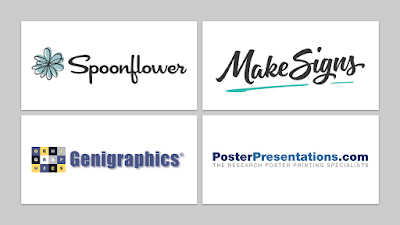There seemed to be an uptick in the number of posters printed on fabric, “synthetic cloth,” and other foldable materials rather than traditional paper. I went through the first three poster sessions and tried to count every poster that was not on paper. About 10 percent of posters (82 of 774) were fabric or similar.
But what was interesting, though, was that different fabric posters looked different. Often quite different. This is something I’d noticed before, but this was the first time I thought to ask people where they got them printed.
I talked to dozens of people, and a few trends emerged.
Spoonflower was the most popular source for fabric posters by a long ways. They printed 25% of the posters that I was about confirmed the printer by talking to the presenter. I saw more posters that I suspected were by Spoonflower, but couldn’t find the presenter to ask.
Spoonflower was the most distinctive looking product. I was able to predict with high accuracy which posters had been printed by Spoonflower by the second poster session. Unfortunately, the distinctive look of Spoonflower posters was not necessarily a positive look. They almost all sagged, and badly.
Many people said they loved Spoonflower because it was cheap. The cost I heard most people quote was about US$20. I think this may be a good case of, “You get what you pay for.” You buy cheap, you get cheap, and it looks cheap.
Spoonflower also has many fabrics, and it was not always clear which people had used (maybe their satin?). Different fabrics will probably give different results.
In fact, one of the best looking fabric posters was a Spoonflower poster. It had almost no sagging on the board. The secret? Corinthia Black hemmed the poster to creating a more rigid seam that held its shape. Her poster was cotton, so she ironed it, and the cotton held up to the ironing well.
PosterSmith was the second most popular single vendor, but had half the number of punters (12.5%) as Spoonflower. Their posters tended to crease or wrinkle rather than sag. At least one person said their poster’s colours didn’t quite look the way they expected.
PosterPresentations, MakeSigns, Genigraphics, and possibly PosterPrint * each had one customer.
The biggest surprise from talking to presenters was how many fabric posters had been printed by their institutions. Over a quarter (29%) were done entirely on campus. This large fraction was not because one large institution sent a lot of people to this conference. The fraction was almost all single posters printed on site by their institutions.
I had not expected that many universities to invest in this sort of non-standard custom printing. But the variety of product was large, and each institution has its own printing quirks. One person said their campus-printed poster smelled a little like fish. (At a biology meeting, some might consider that a feature rather than a bug.)
Ten percent of posters were done by various local printers from where ever the presenter was from. People may use local printers more for SICB than many other conferences, because the meeting is held so soon in January. Many people cannot opt to print their posters on their campus, because all their facilities close for the December holidays.
About 15% of people I talked to did not know where there posters were printed! These were usually students, who designed the poster, but had handed the file over to their professor for printing.
While I felt a little embarrassed for asking about the poster printing rather than the science, many people were happy to talk about how they made their posters. One person said he was more excited to talk about how he made the poster than the project. The project was challenging and the error bars in his graphs were big. I told him, We’ve all had projects like that.”
• • • • •
This was the first SICB conference since the “billboard” style poster was introduced on YouTube last year. It was not a popular format in Texas, with less than half a percent (~0.3%) of posters using the style (3 of 774 posters over three sessions).
• • • • •
* I say “Possibly” here, because I have “PosterPrint” in my notes, but the linked page appears only to offer canvas on frames, not fabric.



No comments:
Post a Comment
Comments are moderated. Real names and pseudonyms are welcome. Anonymous comments are not and will be removed.